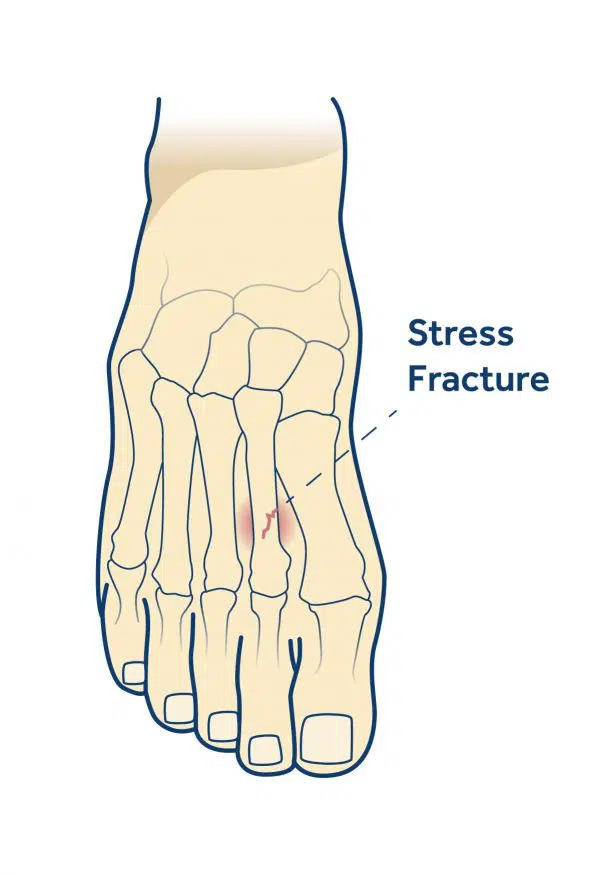What is a Stress Fracture?
A stress fracture is a type of bone fracture, also known as a “Stress Fracture” or “Overload Fracture” in the medical field. This type of fracture occurs when a prolonged and repetitive load is applied to the bone.
Often your bone is forced to bear more load than normal. It only develops when not given enough time to rest and recover.
Symptoms of a stress fracture include pain, tenderness, swelling, redness, and increased pain when you use the area. These fractures are often not visible on x-ray and can be difficult to diagnose. Therefore, it is important for people with developing symptoms to see a healthcare professional for early diagnosis and treatment.
Treatment usually involves rest, meaning the affected area should be kept off load and given time to heal. In advanced cases, treatments such as casting or surgery may also be required. Early diagnosis and appropriate treatment helps stress fractures heal before they lead to more serious complications.
In Whom Are Stress Fractures More Common?
- Athletes,
- Soldiers,
- Dancers
- And it is more common in people who carry repetitive loads, such as other athletes.
These fractures are especially associated with high-impact activities such as;
- Running,
- Walking,
- Jumping,
- And jumping,
where bones are under intense load.
What are The Causes of Stress Fractures?
-
Overload:
The risk of a stress fracture increases when a bone is under more stress than normal. Particularly high-impact sports, overtraining, or weight-bearing can put excessive stress on the bone.
-
Insufficient Rest:
The body needs a rest and recovery period after physical activities. Inadequate rest can weaken the bones’ ability to cope with stress and heal, thus increasing the risk of stress fractures.
-
Not Enought Feeding:
An unbalanced or inadequate diet can affect bone health. Deficiencies in calcium, vitamin D and other important nutrients can reduce the strength and resistance of bones to damage, increasing the risk of stress fractures.
-
Hormonal Changes:
Hormonal changes can affect bone density. And it can increase the risk of stress fractures.
Hormonal changes, especially menopause, can cause bones to become weaker and increase the risk of fractures.
-
Repetitive Movements:
The same movements repeated over and over again create repetitive stress on a bone. For example, situations such as runners constantly stepping on the same foot or tennis players making repetitive strokes can increase the risk of stress fractures in bones.
-
Sport or Activity Changes:
Sport or activity changes that suddenly increase intensity or duration increase the risk of stress fractures when they do not give bones enough time to adjust quickly.
-
Osteoporosis or Low Bone Density:
Bone diseases such as decreased bone density or osteoporosis can cause bones to weaken and increase the risk of stress fractures.
Other causes of stress fractures are as follows:
-
Age:
Older athletes may have bone density problems such as osteoporosis. Weakened bone may develop a stress reaction and fracture earlier than healthy bone.
-
Body Weight:
A person with a low BMI or who is underweight may have weakened bones, while a person with a high BMI and repetitive loading with body weight may also experience a stress fracture.
-
Anatomy:
Abnormalities in the foot can have an impact on how the foot touches the ground. Bunions, tendinitis, and low or high arches are examples of foot disorders. Muscle weakness, imbalances, and lack of flexibility are all possible causes.
-
Gender:
Stress fractures may occur in women who have irregular or absent menstrual periods.
What are The Symptoms of Stress Fracture?
Symptoms of a stress fracture usually occur when a prolonged and repetitive load is applied to the bone.
-
Pain:
You may experience persistent or recurring pain in the area of the stress fracture, especially during or after activity. The pain usually eases during the rest period, but still does not go away completely.
-
Sensibility:
The area where the stress fracture occurs may be tender to touch. Pain may increase when pressure is applied or applied to it.
-
Swelling:
Swelling or slight edema may occur in the affected area.
-
Redness:
There may be a slight redness of the skin in the area of the stress fracture.
-
Difficulty in Using the Area:
Due to a stress fracture, you may have difficulty moving in the affected area. Problems may occur, especially in load-bearing activities.
-
Increasing Pain:
Pain may worsen when you continue to use the area where the stress fracture developed or continue with weight-bearing activities.
Symptoms of a stress fracture may be mild at first, and often the fracture cannot be diagnosed without an x-ray. Therefore, it is important for people who carry repetitive loads on the bones to consult a healthcare professional for early diagnosis and treatment if they have symptoms such as pain and tenderness. Early treatment can prevent more serious complications and enable faster recovery.
In Which Bones Are Stress Fractures Common?
Stress fractures occur most commonly in bones in the lower body. Because these bones carry the entire body weight due to the structure of the human body. Since these bones are the bones that support the weight of the body while standing or moving, the risk of fracture is higher.
- Lower leg (Tibia and Fibula),
- Foot (Especially the bones connecting the ankles and heel to the toes),
- Heel (Calcaneus),
- Lower back (Lumbar Spine),
- Hip,
- Hands and wrists.
How to Diagnose Stress Fracture?
-
Medical History and Physical Examination:
The healthcare provider will take a detailed medical history of your symptoms and perform a physical examination. During this process, you may be asked questions about pain complaints, your activity level, lifestyle and possible risk factors.
-
Imaging Tests:
Imaging tests commonly used to diagnose stress fractures include x-ray, magnetic resonance imaging (MRI), and bone scintigraphy.
-
X-Ray:
The first step in diagnosing stress fractures is usually an x-ray. X-ray images can help detect fracture lines or abnormalities in the bone. However, at the onset of a stress fracture, X-ray images may be normal, making it difficult to detect the fracture at an early stage.
-
MRI:
MRI can be used to detect the early stages of a stress fracture by providing more detailed images. An MRI can show cracks or fractures in the bone more precisely.
-
Bone Scintigraphy:
Bone scintigraphy is a screening test performed by injecting a radioactive substance into the body. Radioactive material may concentrate in areas of fractures or stress fractures, indicating abnormal bone activity.
-
Other Tests:
In some cases, blood tests or other laboratory tests may be ordered to confirm the diagnosis or rule out other possible causes.
How are Stress Fractures Treated?
There are various methods to treat stress fractures. The doctor applies these treatment methods depending on the location and severity of the fracture.
-
Physiotheraphy:
Physical therapy is one of the treatment methods used for stress fractures. Fracture formation is treated with water therapies and pressure applications.
At the same time, exercises help strengthen the area where stress fractures occur.
-
ESWT Treatment:
ESWT treatment used in stress fractures uses sound waves in the treatment method. This treatment method aims to treat the fractured area quickly.
-
PRP Treatment:
PRP treatment is based on injecting platelets obtained from the person’s own blood after suffering a stress fracture. With this method, the aim is for the bone tissue to heal on its own.
-
Operation:
In cases where stress fracture cannot be treated with non-surgical treatment methods, surgical methods are used.
The broken bone tissue is cleaned by surgery. Screwing operations are carried out when necessary.
The healing process of the fractured area varies depending on the location and condition of the broken bone and the patient’s bone measurement values.
It is important that the person tries not to strain himself physiologically during this process, maintains his ideal weight and keeps his immune system strong.
In addition, other treatments used to treat stress fractures include:
- Repetitive stress and overuse play a role in the occurrence of stress fractures. For this reason, it may be recommended to stop the activity that causes the stress fracture.
- An ice pack can be applied to the injured area for approximately 10 minutes. Or an ice massage can be done for 3 to 5 minutes.
- When there is swelling in the ankle and leg, the swelling can be reduced by standing in the correct position. For this, the leg should be lifted off the floor while lying on your back. And his foot should be elevated above the level of the heart.
- Nonsteroidal anti-inflammatory drugs may be recommended to help heal swelling and pain in the fractured area.
- It is recommended to use protective shoes to reduce the stress on the legs and feet. A hard-soled shoe, a wooden-soled sandal or a hard-soled post-operative shoe is useful for this.
- Approximately 2 to 8 weeks of rest is recommended.
- After consulting a doctor, cross-training with non-impact exercises such as swimming or cycling may be recommended.
- During the healing process of a stress fracture, the use of crutches may be recommended to put weight on the foot or leg.
What Happens if a Stress Fracture is Untreated?
-
Exacerbation of Fracture:
If a stress fracture is left untreated, cracks or fractures at the fracture site may progress and turn into a more serious fracture. This can prolong the healing process and make treatment more complicated.
-
Loss of Function:
If a stress fracture is left untreated, pain and discomfort may persist and limit activities. This may cause loss of function in daily life and negatively affect quality of life.
-
Bone Deformity:
If a stress fracture is left untreated, the bones in the fracture area may heal improperly or unfused bone fragments may form. In this case, bone deformities may occur.
-
Chronic Pain:
If a stress fracture is left untreated, the pain can become chronic and persist for a long time. Chronic pain can negatively impact quality of life and limit daily activities.
-
Gait Disorders:
If a stress fracture is left untreated, gait disorders may occur as a result of the bones not healing properly. This condition can affect walking and mobility ability.
-
Fracture Complications:
If a stress fracture is left untreated, the risk of infection or damage to tissues such as vessels and nerves may increase.
These complications can make treatment more complicated.
What are The Stress Fracture Prevention Methods?
Some simple practices can help prevent stress fractures. Listed below are some of the ways to prevent stress fractures.
- Be sure to start any new sports activity slowly and progress gradually.
-
Cross Training:
You can use more than one exercise for the same purpose to prevent injury. For example, you can run on even days and bike on odd days instead of running every day to reduce the risk of overuse injuries. This limits the stress placed on specific muscles, as different activities use muscles in different ways.
- Make sure you follow a healthy diet and include foods rich in calcium and vitamin D in your diet.
- Make sure your child uses appropriate footwear or footwear for any sporting activity and avoids old or worn-out shoes.
- If your child complains of pain or swelling, stop the activity immediately and let your child rest for a few days.

